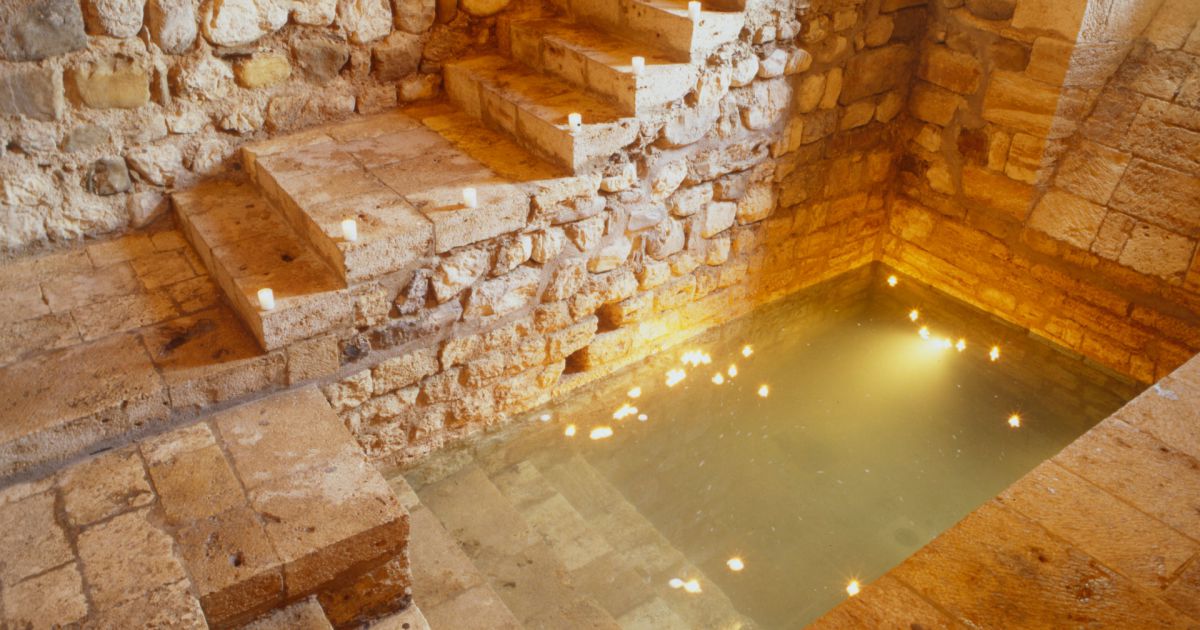Besalú is a town located in the south-east of the comarca of La Garrotxa, between Banyoles, Figueres and Olot, which oozes history from every corner. It hides many centuries of history; the first reference of human population dates from over 2400 years ago. The town has lived through several civilizations. During the Iberian period Besalú was home to human settlements, but it was in the Middle Age when it became most important, due to the creation of the County of Besalú. In this route we will go in depth into the Jewish culture that thrived from the end of the 9th to the 15th century. The Jewish lived in the quarter near the river Fluvià for more then 500 years. The time of its splendour was the second half of the 14th century, when the Jewish community became independent from the one in Girona, but it declined after the confinement of the call – Besalú’s Jewish quarter – in 1931. Progressively, anti-Semitism started to spread amongst the population, and the pressure under which the Jewish community was, forced them to either run away from the city or convert themselves. The route will start in the car park near the bridge, located on the right side of the river Fluvià. Before crossing it, we need to observe the other side of the river and admire the town of Besalú. High up the hill we can see the castle, and, downwards, several Medieval buildings. At the bottom of the hill, near the river, we will see a square. It is the Jewish square (or Plaça dels Jueus), where the old synagogue was. This route will be around this point, the heart and soul of Besalú’s Jewish community. We will cross the bridge to the town. While doing so, we can imagine going back in time, about 500 years ago. We will get to the entrance of the town, where during the Medieval Age there was a toll. Then, we will get into the town by the street next to the Pont Vell (old bridge). A few metres forward, we will turn left until the Jewish square, the ancient synagogue. The synagogue was built as a royal privilege granted by James I the Conqueror, in October 1264. It became the most important building in the Jewry, used for praying, reading and explaining the holy book of the Torah, apart from celebrating the meetings of the aljama, the self-governing Jewish community. Men and women sat in different places, since the best seats in the synagogue were highly appreciated. They were used to trade and often to close commercial deals. On the east side of the square there was the ancient school, of which there are hardly any remains left. The school was an important pillar for the community, the cultural level of the Jews was far higher than the rest of the population. On the other end of the square, there is the entrance to the mikvah, a bath used for the purpose of ritual immersion. Considered a patrimonial treasure, it is one of the few mikvahs dating from the 12th century which can be found in Europe. Of Romanesque style, it is an underground room, far from the public. On the east wall there is a window with a double windowsill and a small incline, which offers light and ventilation. The mikvah is located next to the river, since water needed to access it directly. The waters needed constant renovation so as not to get stagnant, since its purifying purpose had to be guaranteed. This ritual purification consists in going down the last steps and immersing oneself three times inside the water. Jewish women were forced to take part in this ritual several times throughout their lives, mainly on special dates, such as weddings or after giving birth. Going back to the route, we will walk again to the Pont Vell (old bridge). Next to the doorway of the fifth building, we will find out there is a hole. It was used to keep the mezuzah, a symbol identifying a Jewish house. It was wrapped up in a leather or metal case and was left inside the hole. It is not the only one in the town; in fact, there are two more in Casa Astruc, which belonged to the Astruc family, an important Jewish family that lived outside the call. This house, nowadays called Cúria Reial, is located in a cobbled street which leads us to the river Fluvià, in the Carrer del Portalet. From there, we will be able to follow the river path, which heads back to the square and the old synagogue. Following upwards Carrer del Pont Vell (old bridge street), we will get to Plaça Llibertat, from where starts Carrer Comte Tallaferro. In the crossing with Carrer Rocafort there is an old house with a well outside. Following the street we will see the Volta de la Força, a vault part of the first city walls which protected the castle. The perimeter of these walls kept expanding over time. We will be able to see this in the archaeological remains at the top of the street. As you can see, Jewish culture flourished in the town of Besalú, between Gargantell creek and the river Fluvià, during the 12th, 13th, and 14th centuries. It gave rise to great doctors, a lively and organized community, which sometimes had difficult relationships with the rest of the population. Eventually, fanaticism spread, and with it, Jews from Besalú and Catalonia were forced to run away or convert. This was just the prelude of the Edict of Expulsion, an edict issued in 1492 by the joint Catholic Monarchs of Spain ordering the expulsion of Jews from the Iberian Peninsula. Nowadays, however, their memory remains in the rich patrimony they left, and the presence of the Jews in Besalú continues with surnames such as Balmanya, Moshé Besalú, Carcassona or Vides Duran.
